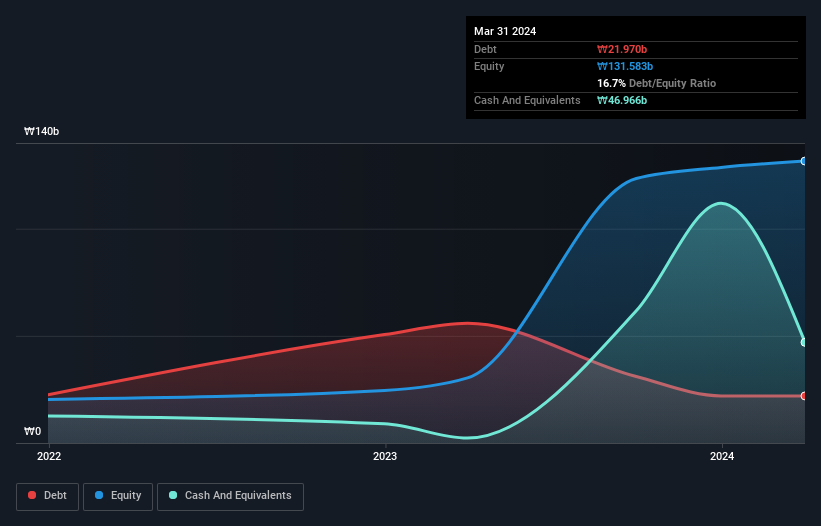- South Korea
- /
- Electrical
- /
- KOSDAQ:A378340
Here's Why Philenergy (KOSDAQ:378340) Has A Meaningful Debt Burden

The external fund manager backed by Berkshire Hathaway's Charlie Munger, Li Lu, makes no bones about it when he says 'The biggest investment risk is not the volatility of prices, but whether you will suffer a permanent loss of capital.' When we think about how risky a company is, we always like to look at its use of debt, since debt overload can lead to ruin. Importantly, Philenergy Co., Ltd. (KOSDAQ:378340) does carry debt. But should shareholders be worried about its use of debt?
When Is Debt Dangerous?
Debt and other liabilities become risky for a business when it cannot easily fulfill those obligations, either with free cash flow or by raising capital at an attractive price. In the worst case scenario, a company can go bankrupt if it cannot pay its creditors. However, a more common (but still painful) scenario is that it has to raise new equity capital at a low price, thus permanently diluting shareholders. By replacing dilution, though, debt can be an extremely good tool for businesses that need capital to invest in growth at high rates of return. When we think about a company's use of debt, we first look at cash and debt together.
See our latest analysis for Philenergy
What Is Philenergy's Debt?
The image below, which you can click on for greater detail, shows that Philenergy had debt of ₩22.0b at the end of March 2024, a reduction from ₩55.9b over a year. But on the other hand it also has ₩47.0b in cash, leading to a ₩25.0b net cash position.

How Healthy Is Philenergy's Balance Sheet?
Zooming in on the latest balance sheet data, we can see that Philenergy had liabilities of ₩77.6b due within 12 months and liabilities of ₩10.1b due beyond that. On the other hand, it had cash of ₩47.0b and ₩2.24b worth of receivables due within a year. So its liabilities outweigh the sum of its cash and (near-term) receivables by ₩38.6b.
Of course, Philenergy has a market capitalization of ₩497.2b, so these liabilities are probably manageable. However, we do think it is worth keeping an eye on its balance sheet strength, as it may change over time. While it does have liabilities worth noting, Philenergy also has more cash than debt, so we're pretty confident it can manage its debt safely.
In fact Philenergy's saving grace is its low debt levels, because its EBIT has tanked 60% in the last twelve months. When a company sees its earnings tank, it can sometimes find its relationships with its lenders turn sour. The balance sheet is clearly the area to focus on when you are analysing debt. But it is future earnings, more than anything, that will determine Philenergy's ability to maintain a healthy balance sheet going forward. So if you're focused on the future you can check out this free report showing analyst profit forecasts.
But our final consideration is also important, because a company cannot pay debt with paper profits; it needs cold hard cash. While Philenergy has net cash on its balance sheet, it's still worth taking a look at its ability to convert earnings before interest and tax (EBIT) to free cash flow, to help us understand how quickly it is building (or eroding) that cash balance. During the last three years, Philenergy burned a lot of cash. While that may be a result of expenditure for growth, it does make the debt far more risky.
Summing Up
While it is always sensible to look at a company's total liabilities, it is very reassuring that Philenergy has ₩25.0b in net cash. So although we see some areas for improvement, we're not too worried about Philenergy's balance sheet. There's no doubt that we learn most about debt from the balance sheet. But ultimately, every company can contain risks that exist outside of the balance sheet. Be aware that Philenergy is showing 2 warning signs in our investment analysis , and 1 of those is significant...
If you're interested in investing in businesses that can grow profits without the burden of debt, then check out this free list of growing businesses that have net cash on the balance sheet.
New: Manage All Your Stock Portfolios in One Place
We've created the ultimate portfolio companion for stock investors, and it's free.
• Connect an unlimited number of Portfolios and see your total in one currency
• Be alerted to new Warning Signs or Risks via email or mobile
• Track the Fair Value of your stocks
Have feedback on this article? Concerned about the content? Get in touch with us directly. Alternatively, email editorial-team (at) simplywallst.com.
This article by Simply Wall St is general in nature. We provide commentary based on historical data and analyst forecasts only using an unbiased methodology and our articles are not intended to be financial advice. It does not constitute a recommendation to buy or sell any stock, and does not take account of your objectives, or your financial situation. We aim to bring you long-term focused analysis driven by fundamental data. Note that our analysis may not factor in the latest price-sensitive company announcements or qualitative material. Simply Wall St has no position in any stocks mentioned.
About KOSDAQ:A378340
Philenergy
Supplies notching equipment and in EV battery equipment in South Korea.
Adequate balance sheet very low.
Market Insights
Community Narratives



